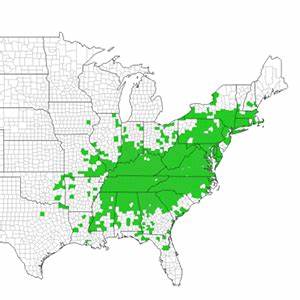 Distribution of Japanese Stilt Grass in the US Distribution of Japanese Stilt Grass in the US Topic suggested by Barry Buschow Alabama Cooperative Extension System describes Japanese stilt grass (Microstegium vimineum) as an aggressive invader of forestlands throughout the eastern United States. Boy is that an understatement! If my small plot of woodlands is any example, stilt grass is a never-ending juggernaut. But as the map below shows, I’m not alone in the Eastern United States in having stilt grass. The plant was accidentally introduced into the Tennessee around 1919 as a result of being used as a packing material in shipments of porcelain from China. Stilt grass is considered one of the most damaging invasive plant species in the United States. It is well adapted to low-light levels. Infestations spread rapidly with flowering and seed production in late summer. The seed can remain viable in the soil for up to five years. Infestations also impact the diversity of native species, reduce wildlife habitat, and disrupt important ecosystem functions. In particular, stilt grass can reduce growth and flowering of native species, suppress native plant communities, alter and suppress insect communities, slow plant succession and alter nutrient cycling. However, it does serve as a host plant for some native satyr butterflies, such as the Carolina Satyr Hermeuptychia sosybius and the endangered Mitchell's Satyr Neonympha mitchellii (Wikipedia). Correct identification is necessary before beginning any management activities. Fortunately, Japanese stilt grass has a unique combination of characteristics that make field identification possible. A field guide published by the Alabama Cooperative Extension System provides simple descriptions and clear pictures of these characteristics along with details on how to distinguish several common look-a-like species. Since Japanese stilt grass is an annual grass, the primary goal is to prevent it from producing seeds. Management techniques include hand pulling, mowing, spraying, burning, goats, and biological control. The New York Botanical Garden's website provides some simple tips on controlling stilt grass. However, choosing the right combination of control methods, applied at the right time, is important so as not to further damage the environment or ecosystem. For instance, the widespread use of herbicides has greatly contributed to wiping out native milkweed plants contibuting to the 80 percent decrease in monarch butterflies in the past 20 years. Everything has trade-offs. Happy pulling! Other References USDA Website
1 Comment
Luma Kennedy
10/5/2022 05:55:19 pm
Hello
Reply
Your comment will be posted after it is approved.
Leave a Reply. |
Have a blog or blog idea?
Let us know (click) Other Blogs
VA Native Plant Society - click Brenda Clement Jones - click John Muir Laws' Blog - click Megan's Nature Nook - click Categories
All
Archives
September 2023
Blog Administrator:
Kathleen A. VMN since 2018 |